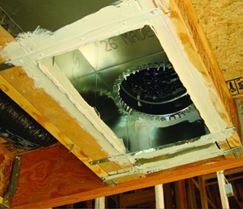
Data from Current Practice in New Homes
The Department of Energy’s Texas Energy Code Field Study shows that almost all new homes built in Texas meet the duct tightness requirements of the 2009 Energy Code. However, only about 15 percent of the new homes surveyed meet the more stringent requirements of the 2015 Energy Code which becomes effective September 1, 2016.
Bringing all new homes into compliance with the Code’s duct testing requirements can save Texas homeowners more than $3.5 million each year in utility bills, make homes more comfortable, durable and healthier while helping to ensure that builders only pay for the HVAC system their homes need and improving installation practices.
Energy Code Requirements
The 2015 IECC/IRC require that duct leakage be tested and that the leakage rate not exceed 4 CFM/100 sq. ft. of conditioned floor space. This is much more stringent that the 12 CFM/100 sq. ft. total leakage required by the previous 2009 IRC state energy code. Duct leakage testing is not required where the ducts and air handler are located entirely within the thermal envelope.
Guidelines for Duct Sealing
Design Duct Systems Using ACCA Manual D
Manual D sizes ducts, plenums and other air distribution system components to meet design air flow, static pressure and air mixing requirements of the system for proper cooling, heating and ventilation. Improperly designed and installed systems reduce air flow to individual rooms creating hot and cold areas within the house.
Use UL 181B Mastic to Seal Duct Joints, Seams and Connections

Use UL 181B mastic to seal duct joints, seams and connections. Photo credit: Building America Solutions Center
Ducts are usually round, often have uneven surfaces and are hard to get to; trying to seal ducts with tape, even UL 181 tapes, is difficult to impossible. Mastics are more forgiving, fill gaps and are much easier to use. To successfully seal ducts, only use UL 181 rated tapes to seal seams on air handler unit boxes and to hold duct board plenums together while mastic is applied to the seams.
Do Not Use Building Cavities as Plenums
The 2009 energy code allowed building cavities to be used as return air plenums. The 2015 code does not allow the use of building cavities as ducts or plenums.
Seal Supply Boots and Return Boxes to the Finish Surface
The connection between supply boots or return boxes and drywall or other finished surface is a major source of duct leakage into attics or other unconditioned spaces. Seal all areas where boots or boxes penetrate the drywall or other finished surface.

Seal supply boots and return boxes to the finish surface. Photo credit: Building America Solutions Center
Test Ducts at Rough-in or Post Construction
According to the Energy Code, ducts must be tested either at the rough-in stage of construction or at post construction. Each has advantages. Testing at rough-in lets the contractor know the ducts are tight before they are enclosed with drywall and insulation. Testing at post construction ensures that any damage to the ducts during construction is identified.
Duct Sealing Resources
Air Conditioning Contractors of America:
Manual D for code officials – http://www.acca.org/wp-content/uploads/2014/01/Manual-D-Brochure.pdf
This brochure from ACCA provides a good overview of duct design for code officials and builders. ACCA also has many resources and training available to HVAC contractors.